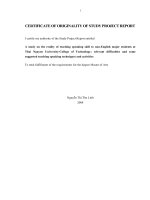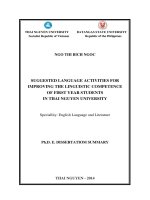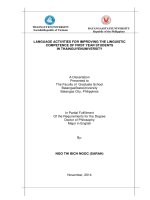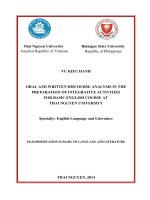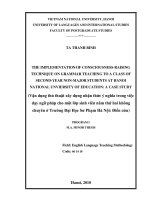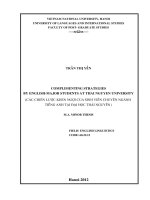Enhancing management measures on students self study activities at Thai Nguyen university of sciences
Bạn đang xem bản rút gọn của tài liệu. Xem và tải ngay bản đầy đủ của tài liệu tại đây (362.29 KB, 8 trang )
ISSN: 1859-2171
e-ISSN: 2615-9562
TNU Journal of Science and Technology
225(03): 33 - 40
ENHANCING MANAGEMENT MEASURES ON STUDENTS' SELF- STUDY
ACTIVITIES AT THAI NGUYEN UNIVERSITY OF SCIENCES
Phi Dinh Khuong*, Lam Thuy Duong
TNU - University of Sciences
ABSTRACT
This study indentified the performance of the self-study activities of students in terms of: students'
awareness on self-study, study skills, services for self-study, teaching method and administration.
Specially, it aimed to find out the factors both externally and internally that may affect the activities
of students' self-study; to find out the relationship between self-study activities and factors affecting
the self-study activities; to identify the different management measures of self-study activities; to
assess the necessity and feasibility of the management measures for self-study activities; to develop a
management measures for students self-study activities based from its necessity and feasibility. It is
designed to help determine the extent to which different variables are related to each other in the
population of interest. The study would provide leaders with a clear idea on how effective and
successful they should have in the work as management of self-study in university.
Keywords: Self-study activities; management of self- study; management measures of self-study
activities; characteristics of students' self-study activities; the nature of management of self-study activities.
Received: 22/8/2019; Revised: 23/9/2019; Published: 30/9/2019
NÂNG CAO BIỆN PHÁP QUẢN LÝ HOẠT ĐỘNG TỰ HỌC CỦA SINH VIÊN
TRƯỜNG ĐẠI HỌC KHOA HỌC - ĐẠI HỌC THÁI NGUYÊN
Phí Đình Khương*, Lâm Thùy Dương
Trường Đại học Khoa học - ĐH Thái Nguyên
TÓM TẮT
Nghiên cứu đã xác định được thực trạng của hoạt động tự học của sinh viên về các phương diện:
nhận thức, kỹ năng, các điều kiện phục vụ cho tự học, phương pháp giảng dạy, công tác quản lý.
Xác định các yếu tố ảnh hưởng đến hoạt động tự học bao gồm cả yếu tố khách quan và yếu tố chủ
quan. Tìm ra mối quan hệ giữa hoạt động tự học và yếu tố ảnh hưởng đến hoạt động tự học, đề
xuất các biện pháp quản lý hoạt động tự học.Tác giả đã sử dụng phương pháp mô tả, phân tích để
tìm ra được sự liên quan đến nhận thức giữa các nhóm đối tượng, đồng thời tìm ra những yếu tố có
ảnh hưởng đến hoạt động tự học của sinh viên. Nghiên cứu sẽ cung cấp cho các nhà lãnh đạo một
ý tưởng rõ ràng về hiệu quả và thành công của các hiệu trưởng trong công việc quản lý hoạt động
tự học của sinh viên trong trường đại học.
Từ khóa: Hoạt động tự học; quản lý hoạt động tự học; biện pháp quản lý hoạt động tự học; đặc điểm
của hoạt động tự học của sinh viên; bản chất của quản lý hoạt động tự học.
Ngày nhận bài: 22/8/2019; Ngày hoàn thiện: 23/9/2019; Ngày đăng: 30/9/2019
* Corresponding author. Email:
DOI: />; Email:
33
Phi Dinh Khuong et al
TNU Journal of Science and Technology
1. Introduction
For the level of higher education, the
requirements on methods in Article 40 of the
Vietnamese Law on Education (2005) states:
"Methods of college and university education
must pay attention to the advancement of the
self-consciousness in study, of ability of selfstudy, self-taught,
developing creative
thinking, drilling of practical skills, facilitate
students in participating in research,
experimentation and application"[1].Thai
Nguyên University of Sciences (TNUS) was
established on 24 October 2002 on the
foundation of Faculty of Natural and Social
Sciences-Thai Nguyen University. TNUS has
total staff of over 300 in which, there are 8
associate professors, 90 doctors, 138 masters
and 66 teachers are taking PhD coures. The
number of students in 2018- 2019 is 4000. Its
goal is to become a university which educates
and trains students in multi disciplines and
branches, and serves as a research centre of
science and technology, meeting the need of
economic, cultural and social development in
Thai Nguyen province and her neighbors.
However with the increasing requirements on
the qualification of human resources, the
schools should have the synchronizationed
solutions to improve the quality of training.
These solutions must be oriented to studentsthe subject of the training process. From the
above problems, the identification of
measures to organize, manage study activities
of students of TNUS in order to improve the
quality of school education is a critical issue.
2. Literature review
Entering the twenty-first century, human
beings have encountered drastic changes of
modern civilization as the result of the
achievements of science and technology
created breakthroughs in all areas of social
life [2], [3]. Education is considered a key
factor for the development of the society as
required by that trend. With the development
of science and technology, the amount of
34
225(03): 33 - 40
human knowledge has been increased every
second while time for learning in the school is
limited. Therefore, being equipped with selfstudy method to acquire the knowledge is an
inevitable trend [4], [5].
Many authors mentioned and approached selfstudy, our perspective self-study is a form of
cognitive activity of individuals [6]. It is a
voluntary and positive activity, self-promote
their own internal resources to acquire
knowledge, skills and techniques [7], [8]. Selfstudy is a way of dy in which people study with
self-awareness,
positively,
proactively,
independently to capture knowledge in a certain
area of life in order to achieve their goals [9].
Over the past years, TNUS has made great
efforts in training human resources for Thai
Nguyen province and the region, due to the
increasing requirements on the qualification
of human resources, the university should
have the synchronization solutions to improve
the quality of training. These solutions must
be oriented to students - the subject of the
training process [10], [11]. In fact, most of the
fresh students do not have the habit of active
and positive study, self-study skills but their
study mainly relies on the knowledge imparted
by college instructors [12,[13]. In addition,
factors such as physical facilities, textbooks
and curricula for teaching and learning have
many shortcomings affect the quality of school
education [14], [15]. With the above reasons,
author chose the topic: "Enhancing the
management measures of students' self-study
activities at Thai Nguyen University of
Sciences" to propose management measures
with the aim of improving the university’s
quality of education.
3. Methodology
Scope and Limitation of the Study
This study was conducted at TNUS. The
respondents were composed of 148
administrators and 308 students from the
different faculties and departments of TNUS.
; Email:
Phi Dinh Khuong et al
TNU Journal of Science and Technology
Population and Sampling
148 of teaching staff (65 %) of nine
functional departments and training divisions
and 308 of students (10 %) of eight faculties
of the university were requested to answer the
questionnaires. Instrumentation
The author designed a questionnaire, which is a
main tool in gathering data. The questionnaires
are divided into parts namely: survey
questionnaire on the status, the survey on the
necessity and feasibility of the measures.
Data Gathering Procedure
The researcher asked permission from
different heads of TNUS to conduct his study.
Upon approval, he administered the
questionnaire to his respondents. He
explained clearly the purpose of the study and
after answering the instrument, he retrieved
them on the same day. The data were tallied,
tabulated and analyzed afterwards.
Statistical Treatment
- Weighted mean was utilized to describe the
perception of the status of self-study
activities, the factors that may affect the
students'
self-study
activities,
the
management measures.
- Chi-square test, for determining the
significant relationship of the self-study
activities and the factors that may affect the
students' self-study activities.
- To see the correlation between the necessity
and feasibility of the self-study activities
management measures as mentioned, we use
4.2. Discussions
225(03): 33 - 40
the formula coefficients' hierarchy Specimen
to calculate.
4. Results and discussions
4.1. Results
This study will be beneficial to objects listed
as follows:
Students: They will be benefited by this study
because they are the main concern of training
process. From the results of the study, students
can recognize both strengths and weaknesses
of situation on students' self-study activities in
so that each student should clearly dentify their
motivation, attitude and self-study methods to
achieve high academic results.
Lecturers: The outcome of the study is of
great help to lectures have more awareness of
the factors affecting the activities of students'
self-study. Since then, each lecturer will take
measures to raise awareness and self-study
skills for students, making them more active
and proactive in self-study activities. Also,
this study will help them identify measure to
improve the efficiency of selflearning
activities for students to contribute to
improving the quality of school education
Administrators: It is hoped that the study will
help the administrators to see the status of
self-study activities, the management of selfstudy activities of the school, and provide
them with the management measures used for
reference in managing selfstudy activities of
students in the university.
Status of the self-study activities
Table 1. Frequency and Weighted Mean Distribution on the status
of students’ self-study sctivities as to its awareness on self-study
VMA
A
NA
SNA
Statement
4
3
2
1
I am aware of the;
Activities of the self-study program.
Goals/objectives of the self-study program.
University program on self-study.
Procedure on how to conduct the self-study activities.
Benefits of the self-study activities.
Average weighted mean
; Email:
73
64
66
48
131
244
251
253
235
185
11
10
11
37
12
3
1
0
5
2
WM
QD
3.17
3.16
3.16
3.0
3.36
3.17
A
A
A
A
A
A
35
Phi Dinh Khuong et al
TNU Journal of Science and Technology
225(03): 33 - 40
Table 1 points out the result of self-study cognition activities on 5 contents, weighted average result is
3.17, meaning that students all are aware of the importance of the self-study. Criterion number 5 is
3.36 points, revealing that students are aware of the benefits of the self-study at the highest level.
Table 2. Frequency and Weighted Mean Distribution on the status
of students' self- study activities as to its study skills
SA
A
D
SD
Statement
4
3
2
1
The Self-study activities help me to:
Enhance my critical thinking skills.
141
177
9
1
Enhance my comprehension skills.
143
174
11
0
Develop my reading skills.
128
180
14
6
Develop my note taking skills.
132
176
18
2
Develop my time management skills
120
192
12
4
Enhance my problem solving skills.
116
182
26
4
Average Weighted Mean
WD
QD
3.39
3.40
3.32
3.34
3.30
3.25
3.33
SA
SA
SA
SA
SA
SA
SA
Table 2 shows the evaluation results of the self-study impact on improving learning skills. The
weighted average result is 3.33, the skill that is assessed to be at highest point level is the 2nd skill
– comprehension skills with the 3.4 weighted average points; the skill assessed to be the lowest
point is the recording skill.
Table 3. Frequency and Weighted Mean Distribution on the status
of students' self- study activities as to students' habits during self- study
O
S
R
Statement
4
3
2
I browse the headings, pictures, chapter questions and summaries
153 149 25
before I start reading a chapter.
When I self-study, I do first the difficult subject.
126 155 41
I try to get the meaning of new words as I see them for the first time. 118 147 56
I review my class notes after class.
107 152 56
I take notes as I read my text books/reading materials.
90 136 73
I study for a length of time then take a short break before returning
123 145 49
to studying.
I have all my supplies handy when I study, such as pens, paper,
196 95
32
calculator, etc.
Average Weighted Mean
N
1
WD QD
1
3.39
O
6
7
13
29
3.23
3.15
3.07
2.82
S
S
S
R
11
3.16
S
5
3.47
O
3.18
S
Table 3 shows assessment result on 07 habits in the self-study, the result of these seven contents
is 3.18 point, which is at credit level; the highest score is of the 7th content with 3.47 point, ie that
the students have habits to prepare well the learning tools. The most popular habit in the selfstudy is to review the class notes.
Table 4. Frequency and Weighted Mean Distribution on the status
of students' self- study activities as to Services for self-study support
SA A D SD WD QD
Statement
4
3
2
1
There is an available place to conduct self-study around the school campus. 150 132 36 10 3.29 SA
Books and other reading materials are available to use for self-study.
132 157 35 4 3.27 SA
Wi-fi /Internet access is provided for self- study.
148 143 30 7 3.32 SA
The library is always available for self- study
155 149 18 6 3.38 SA
Vacant classrooms are allowed to be used for self-study.
128 151 42 7 3.22 A
Resources like radio, television and other electronic media are available
112 166 45 5 3.17 A
for self-study.
Average Weighted Mean
3.28 SA
36
; Email:
Phi Dinh Khuong et al
TNU Journal of Science and Technology
225(03): 33 - 40
Table 4 shows the survey of services for the self-study support with six contents, with the result
of 3.28 point, ie basically, service conditions for the self-study have met the needs of students.
Accordingly, the library service is assessed to be at the highest level of 3.38, the media is at the
lowest level with 3.17. This reflects correctly the reality of the university currently.
Table 5. Frequency and Weighted Mean Distribution on the status
of students' self- study activities as to Teacher initiative
SA A D SD WD QD
Statement
4
3
2
1
Teacher plans specific activities outside class hours and self-study
147 159 20 2 3.38 SA
activities of students.
Teachers give tasks to do at home.
120 195 12 1 3.32 SA
Teachers require students to engage in self-study activities daily.
110 188 30 0 3.24 A
Teachers ask students to read books and references before and after class. 146 159 21 2 3.37 SA
Teaching method use promotes the self- study activities
125 178 24 1 3.30 SA
Methods of testing and assessment require students to do self-study.
113 181 32 2 3.23 A
Average Weighted Mean
3.31 SA
Table 5 shows the assessment of the teacher initiative with seven contents. Average result is 3.31,
ie the contents are highly appreciated and activities of teachers have great effect on the self-study
of students.
Table 6. Frequency and Weighted Mean Distribution on the status
of students' self- study activities as to self- study location
O
S
R
N
WD
Statement
4
3
2
1
I usually do my self-study at……
Home
234
70
19
5
3.63
Friends house
59
74
55
140
2.16
Dorm
156
118
46
6
3.30
Quiet place
32
166
105
27
2.62
Any vacant space around the campus
64
180
57
27
2.86
Vacant classroom
58
115
88
67
2.49
Library
50
100
87
91
2.33
Average Weighted Mean
2.77
QD
O
S
O
S
S
R
S
S
The survey result shows that learning at home is the most popular choice with 3.63 average
points, next is the self-study at silent places with 3.30 points. General result is 2.77 points,
meaning that students do not choose any fixed place.
Table 7. Frequency and Weighted Mean Distribution on the status
of students' self- study activities as to administration
ACO CO UNO NCO WD QD
Statement
4
3
2
1
Manages faculty's teaching activities to influence student self-learning.
125 154 35
13 3.20 CO
Motivates students to engage in self-study activities to enhance learning. 70 186 69
3 2.99 CO
Supervise monitoring and assessment of students' learning outcomes
50 176 89
12 2.80 CO
based from self- study activities.
Manages self-study activities outside of class hours.
92 173 47
16 3.05 CO
Manages the implementation of students‟ self-study activities.
105 187 33
2
3.2 CO
Coordinates departments and organizations in the implementation of
65 177 67
19 2.89 CO
students' self-study activities..
Average Weighted Mean
3.02 CO
; Email:
37
Phi Dinh Khuong et al
TNU Journal of Science and Technology
Table 7 shows the evaluation of the university
management on the self-study activities with
six contents, the average result of management
content is 3.02 points, ie these contents are
frequently carried out. The 1st content gets the
highest score with 3.2 points; it is the
management on teaching activities of teachers
to positively affect on the self-study of
students. The lowest score is of management
on the self-study activities outside of class time
with 2.8 points. This fact is consistent with the
actual situation of the university.
Survey results
Measure 1: Planning management of the selfstudy, necessity to evaluate average point X=
2.95, ranking 5th order; feasibility X=2.87
ranks 5th order.
Measure 2: Organizing activities to raise
awareness, building attitude and self-study
skills training for students, necessity to
evaluate average point X=2.98 ranking 1st
order; feasibility X=2.96 ranking 2nd order.
Measure 3: Implement renovation of teaching
method in order to develop the self-study
activeness, necessity of evaluation X=2.97
average point ranking 2nd order; feasibility
X=2.96 ranking 2nd order.
Measure 4: Strengthening scientific research
activities to promote the self-study
motivation, necessity of evaluation with
average point of X=2.97 ranking 2nd order;
feasibility X=2.97 ranking 1st order.
Measure 5: Organizing and managing extra
curriculum activities of students, necessity of
evaluation X=2.97 average point ranking 2nd
order; feasibility X=2.91 ranking 3rd order.
Measure 6: Manage and use efficiently
facilities for the self-study activities, necessity
of evaluation X=2.97 average point ranking 2nd
order; feasibility X= 2.88 ranking 4th order.
In terms of necessity, ranking 1st order is the
1st measure with X=2.98 average point; The
measure of activity organization to enhance
awareness, to construct motivation, attitude
38
225(03): 33 - 40
and self-study skill for students is one, which
directly affects on students.
In terms of feasibility, ranking 1st order is the
4th measure with X=2.97 average point; the
measure of scientific research activity
increase to develop self-study motivation is a
good method to arouse the independence,
creativeness of learners.
In order to see correlation between the
necessity and the feasibility of the
management measures of the students' selfstudy activities, the author uses the ranking
correlation coefficient formula of Specimen:
R=0.88 showed the following:
- The relationship between the necessity and
feasibility of the management measures are
positively correlated because R=0.88 marked
(+), which is closely correlated, ie the
necessity and feasibility of the management
measures are highly relevant.
- The necessity of measures is at which
extent, the feasibilities will be at the
respective level. From the test results,
teachers
and
managers
interviewed
appreciated the necessity and feasibility of the
measures proposed by the author. This shows
that the proposed measures in the thesis is the
basis for the practical application of the selfstudy management of students' TNUS.
5. Conclusions and recommendation
5.1. Conclusions
Based on the findings, the reseacher came up
with the following conclusions:
1. For students' level of awareness on the selfstudy activities with an average weighted
mean of 3.17 following Likert. Students'
awareness on self- study: Students are
obtaining
better
outcomes
for
the
improvement of their academics as resulted
from the instituition's program on self- study
2. For students' self- study skills with an
average weighted mean of 3.33. Study skills:
Students have good understanding of the
importance of study skills for their
enhancement in acadamic performances.
; Email:
Phi Dinh Khuong et al
TNU Journal of Science and Technology
225(03): 33 - 40
3. For students' habits during self-study with
an average weighted mean of 3.18. Habits
during self-study basically meet the
requirement of self-study. They spend time to
review the class notes after class and prepare
all the supplies handy when studying. The
habits during self-study that require the
initiative and creativity in self-study of
students is not high. They mainly focuss on
the content following the guidance of teacher.
- Give more investment on facilities catering
for teaching and learning in a systematic and
modern standard. Effective exploitation of the
Center for Information and electronic library
to provide full and timely documentation of
teaching and in service learning.
4. Services for self-study support with an
average weighted mean of 3.28. Services for
self-study generally provide the the basical
need of students for their study but the study
resources are not highly appreciated.
- Organize multiple playgrounds, useful forum
for students, such as students studying science
club courses, conferences and seminars on
self-learning method for students; Stock
powerful movement for autonomy in learning;
movement launched initiatives proposed in
academic and creative ideas.
5. Teaching method with an average weighted
mean of 3.31. Self-study location is the
atracted issue to student. In general, students
are facing with difficulties in finding a place
to study. Students often choose to study at
home and a quiet place
6. Self-study location with an average
weighted mean of 2.77. Teaching initiative is
considered the decisive factor to the selfstudy method of students.
7. Administration with an average weighted
mean of 3.02. Administration level reflects
that the school have been applying the certain
measures for self-study management.
5.2. Recomendation
Based on the findings of the study, the
following are recommended:
- The director board should pay more
attention to policies, direction in management
of students’ self-study activities. Concretize
them in written documents; the guiding
ideology of the school to the relevant
department implemented a basis.
- Enhanced direct the innovation of teaching
methods, assessment of teachers towards
promoting
positivity of the school;
organizing regularly practical activities,
forging skills for students.
; Email:
- Enhance training methods and student
study skills, self-study, arouse desire in
student learning, making students more
interested in learning.
- The director board should pay more
attention to organize activities for students
practical approach, promoting the spirit of
volunteerism for community life, such as
voluntary youth movement; application of
scientific advances to life, linking theory
with practice through which students are
constantly learning and trying in practice,
there is more a sense of responsibility for
themselves, their community and society.
REFERENCES
[1]. Education Law, National Political Publishing
House, Hanoi, 2005.
[2]. H. C. Nguyen, Vietnam Education early years
of the twenty-first century, Education Publishing
House, 2007.
[3]. Forecast for the twenty-first century,
Statistical Publishing House, 1998.
[4]. Q. B. Dang, A new approach to scientific
management and the application in educational
management, 1995.
[5]. C. D. Vu, Curriculm research methodology,
Education Publishing House, 2007.
[6]. F. E. Weinert, The development of cognitive
learning and teaching, Education Publishing
House, 1998.
[7]. T. N. Pham, Management of quality in higher
education, National University Publishing
House, Hanoi, 2000.
39
Phi Dinh Khuong et al
TNU Journal of Science and Technology
[8]. C. T. Nguyen, The process of self-study
training, study and train how to study, 2004.
[9]. C. T. Nguyen, Collection of works of selflearning and self-education self-study,
Educational publishing house, 2001.
[10]. Ministry of Education & Training, Regulation
of higher education and college system of
government under the credit system, 2007.
[11]. V. D. Nguyen, Self- study is the experience
of a lifetime of every human being, selflearning and self-training - the strategic
40
225(03): 33 - 40
thinking of Vietnamese educational development,
Education Publishing House, Hanoi, 1998.
[12]. K. D. Tran, Management and quality
control of personnel training, Education
Publishing House, 2004.
[13]. P. Exipov, The theoretical basis of
teaching, Educational Publishing House,
Hanoi, 1997.
[14]. K. C. Pham, Commenxiki-father of modern
pedagogy, Education Publishing House, 1997.
[15]. D. C. Nguyen, Quality Management trainingthematic project for junior teachers, 2004.
; Email:
